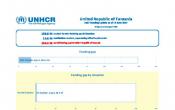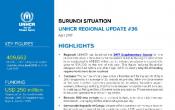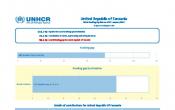United Republic of Tanzania
Operation: United Republic of Tanzania
Location
{"longitude":35,"latitude":-6,"zoom_level":0}
Latest update of camps and office locations 21 Nov 2016. By clicking on the icons on the map, additional information is displayed.
Key Figures
| 2016 end-year results | |
| 198,000 | individuals (including 3,500 new-born children) registered using UNHCR’s ProGres database |
| 41,100 | Burundian refugee children and 37,380 Congolese refugee children were enrolled in primary education |
| 3,200 | sexual and gender-based violence (SGBV) incidents were reported among Burundian and Congolese community |
| 11,100 | transitional shelters were constructed with coverage of 28 per cent across the three camps |
| 9% | of the Burundian and Congolese refugee populations in Nyarugusu camp received liquefied petroleum gas (LPG) as part of a pilot |
| 2017 planning figures | |
| 70,100 | refugee children will be enrolled in primary education |
| 6,500 | dossiers of persons of concern will be submitted for resettlement to a third country |
| 700 | transitional shelters will be constructed |
| 94% | of households in need will receive core relief items |
| 64% | of households in camps will live in adequate dwellings |
| 64% | of households will have a drop-hole latrine or drop-hole toilet |
More Information
People of Concern
20%
Increase in
2016
2016
| 2016 | 458,828 |
| 2015 | 382,620 |
| 2014 | 252,357 |

[["Refugees",281498],["Asylum-seekers",8539],["Returned refugees",6],["Others of concern",168785]]
Loading ...
United Republic of Tanzania
< Back
2016
{"categories":[2012,2013,2014,2015,2016,2017],"budget":[79.97641905,39.65703876,38.21491383,134.15516444,108.50987822,137.07214279],"expenditure":[21.51766799,19.39590816,24.6811937,48.87004149,69.99019142,null]}
{"categories":[2012,2013,2014,2015,2016,2017],"p1":[21.4658967,15.86371529,23.19500923,118.73635308,96.04563581,126.64062901],"p2":[null,null,null,null,null,null],"p3":[58.51052235,23.79332347,15.0199046,15.41881136,12.46424241,10.43151378],"p4":[null,null,null,null,null,null]}
{"categories":[2012,2013,2014,2015,2016,2017],"p1":[14.79110555,13.24639973,20.0803866,42.24403878,65.51548653,null],"p2":[null,null,null,null,null,null],"p3":[6.72656244,6.14950843,4.6008071,6.62600271,4.47470489,null],"p4":[null,null,null,null,null,null]}
Loading ...
CHOOSE A YEAR
- 2014
- 2015
- 2016
- 2017
Working environment
The Government of the United Republic of Tanzania remained committed to its international legal obligations of protecting refugees and asylum-seekers. Nonetheless, freedom of movement remained challenging in 2016 due to an encampment policy under the ‘’1998 Refugee Act and 2003 Refugee Policy’’. The “Tanzania Strategy for Local Integration Paper” for the new Tanzanian Citizens is currently under review.In response to the increasing number of arrivals from Burundi, UNHCR advocated with the Government to allocate new land in order to establish a new camp, pending a decision at the end of 2016.
Population trends
- By the end of 2016, some 267,770 refugees mainly from Burundi and DRC were residing in Nyarugusu, Nduta and Mtendeli camps.
- 95 per cent of Congolese were hosted in Nyarugusu camp from South Kivu Province and 3 per cent from Katanga Province, while the Burundian refugees are mainly ethnic Hutus.
- The United Republic of Tanzania embarked on Group Resettlement of approximately 30,000 Congolese refugees to the United States of Americas, which is expected to run for the next five years.
Achievements and impact
- Construction and renovation of infrastructure projects aimed at supporting local government capacity in the areas of rule of law, education, health and water were completed.
- Some 8,900 refugees departed to third countries for resettlement.
- The ‘’Tanzania Strategic Plan for Local Integration of New Citizens’’ was finalized.
- Solutions Alliance was launched with memberships of over 16 development and humanitarian stakeholders.
- Multi-year Multi Partner Protection and Solution strategy for three years with five strategic objectives.
Unmet needs
- Access to territory, particularly from the Democratic Republic of the Congo entry points, hampered by lack of UNHCR staff positioned along the borders.
- Uncertainty regarding land allocation for new camps hindered planning and implementation in 2016.
- At least 1,150 additional classrooms as well as increased number of qualified teachers were needed to enhance access to primary education in camps. Current classroom-to-student ratio stands at 1:200 for double shift.
The United Republic of Tanzania (Tanzania) faces a number of domestic challenges, including recurrent conflict-induced displacement and refugee influxes from neighbouring countries. In 2016, the geopolitical context will have a bearing on national politics, security, and the rights and entitlements of people of concern.
Given the continued deterioration of the security situation in eastern Democratic Republic of the Congo (DRC), and lately in Burundi, the Government of Tanzania continues to host and provide protection space to asylum-seekers and refugees. Some 162,150 former Burundian refugees who fled their country in 1972 have been naturalized, and the Government is fully supportive of integrating them into the country, both politically and socio-economically.
In 2016, UNHCR’s priorities will be to provide humanitarian assistance, including livelihoods support, for Congolese refugees in a protracted situation, as well as for newly arrived Burundian refugees; to proceed with the resettlement of vulnerable Congolese refugees; and to further support the local integration of newly naturalized Tanzanians (former Burundian refugees).
In case of a funding shortfall in 2016, the sectors most critically affected will include the maintenance of camps, the resettlement of some 6,000 people of concern and support for the local integration process, which includes community projects and other socio-economic and legal services for 200,000 individuals.






